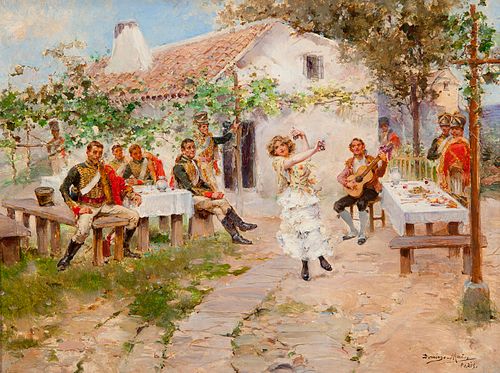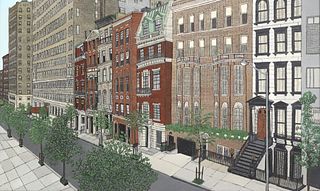DOMINGO MUÑOZ CUESTA (Madrid, 1850 - 1935). "Spanish Dance", Paris. Oil on panel.
Lot 107
About Seller
Setdart Auction House
Carrer Aragó 346
Barcelona
Spain
Setdart Subastas was born in 2004 and is currently the first online art auction in Spain with solidity, prestige and reliability guaranteed by our more than 60,000 users. Setdart has a young, dynamic and enterprising team ready to successfully manage the purchase and sale of art works through custom...Read more
Estimate:
EUR€4,000 - EUR€5,000
$4,301.08 - $5,376.34
Absentee vs Live bid
Two ways to bid:
- Leave a max absentee bid and the platform will bid on your behalf up to your maximum bid during the live auction.
- Bid live during the auction and your bids will be submitted real-time to the auctioneer.
Bid Increments
| Price | Bid Increment |
|---|---|
| EUR€0 | EUR€10 |
| EUR€200 | EUR€25 |
| EUR€500 | EUR€50 |
| EUR€1,000 | EUR€100 |
| EUR€3,000 | EUR€200 |
| EUR€5,000 | EUR€500 |
| EUR€10,000 | EUR€1,000 |
| EUR€20,000 | EUR€2,000 |
| EUR€50,000 | EUR€5,000 |
About Auction
By Setdart Auction House
Nov 10, 2021
Set Reminder
2021-11-10 08:00:00
2021-11-10 08:00:00
America/New_York
Bidsquare
Bidsquare : 19th & 20th Century paintings and Decorative Arts
https://www.bidsquare.com/auctions/setdart-auction-house/19th-20th-century-paintings-and-decorative-arts-7800
Setdart Auction House sofia@setdart.com
Setdart Auction House sofia@setdart.com
- Lot Description
DOMINGO MUÑOZ CUESTA (Madrid, 1850 - 1935). "Spanish Dance", Paris. Oil on panel. Signed and located in the lower right corner. Measurements: 26.5 x 35 cm; 59 x 67 cm (frame) Domingo Muñoz was formed in the School of San Fernando and with Francisco Domingo. After finishing his studies he worked as a caricaturist in "Mundo Cómico", and as a cartoonist for several publications, such as "La Ilustración Militar". In 1876 he was awarded a prize in the competition of "La Ilustración Española y Americana", and the following year he participated for the first time in the National Exhibition of Fine Arts. In this period he exhibits his works in the Society The Watercolor, of the Artistic Circle of Madrid. He resides in Rome since 1880, where his work will gather the influence of Vicente Palmaroli. In the Italian capital his paintings framed in the War of Independence acquired great fame. From Italy he sent canvases to Spain, to exhibitions such as that of the CÃrculo ArtÃstico de Madrid, obtaining notable success. In these years, moved by an offer from the French art dealer Goupil, he moved to Paris, where he settled in 1884. There he won a prize at the Salon of the same year, and soon opened his own studio, where he had as disciples painters of the stature of the Alvarez Dumont brothers. In Paris, Muñoz would devote himself to depicting Andalusian genre scenes, as well as oriental themes, all genres that were in great demand by the public at the time. His work as a painter of military themes was also outstanding, a genre in which he competed with his friend José Cusachs. In 1899 he spent a season in the mountains of Guadarrama, in order to take notes for the paintings of Spanish themes that he would later paint in Paris. During these years he continued to participate in the Nationals of Madrid, where he obtained a second medal in 1901. Shortly after he returned to Spain, and in his last years he was named Knight of the Order of Carlos II. Domingo Muñoz is represented in museums such as the Camón Aznar Museum in Zaragoza, the Army Museum in Madrid or La Casa del Angel in Malaga, as well as in many prestigious private collections, both in Spain and abroad.
- Shipping Info
-
In-house shipping available. Please inquire at admin@setdart.com.
-
- Buyer's Premium



 EUR
EUR CAD
CAD AUD
AUD GBP
GBP MXN
MXN HKD
HKD CNY
CNY MYR
MYR SEK
SEK SGD
SGD CHF
CHF THB
THB















